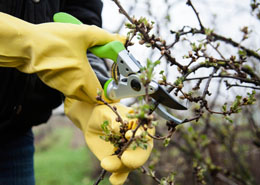Trimming bushes and shrubs at the correct time is required for maintaining a healthy garden. This article provides some useful gardening information on how to trim bushes without causing damage to the plants.

When it comes to beautifying the landscape design, shrubs and bushes are as valuable as the flowering seasonal plants and trees. They are the green component that adds an attractive, colorful background to any type of garden. The required growth factors (temperature, sunlight, humidity, etc.) may vary from one variety to another. So, it is best to know the bushes' requirements for their healthy maintenance.
You can select any type of shrub species, either flowering or non flowering, based on the prevailing climatic conditions and the soil type in your area. Like any other garden plant, nurturing and seasonal caring is important for maintaining disease-free shrubs and bushes. Trimming bushes at the appropriate time is also necessary for good growth and prevention of diseases. Though it can be done at any time of the year, spring and fall are the best for thinning the branches. Nevertheless, some of the bush species may require a specific time period for pruning and trimming.
Ask any gardening hobbyist regarding the maintenance tips of bushes and you will get the same answer, providing the essential growth factors and timely trimming. Pruning is beneficial for overgrown shrubs, while trimming benefits healthy bushes. Some of the advantages of trimming bushes and shrubs are removal of diseased branches, promoting faster growth, giving shape, and limiting the size of the plants.
Wear Safety Gear
For any gardening-related activity, safety is the first priority. So, make sure you wear gear like hand gloves and protective glasses. This will also help in avoiding the risk of skin allergies in case you are hypersensitive to the plant exudate. In order to protect yourself from the harsh rays of the sun, you can start trimming bushes in the morning time.
Correct Time
The most important part about trimming bushes and shrubs is doing so at the appropriate time. Trimming the bushes in spring time will promote new shoot growth in summer. Likewise, trimming in the fall is best for the hardy bush varieties. Opt for trimming in the winter if it suits the particular variety that you have planted in your yard.
Trimming Equipment
For trimming bushes and trees, you should use sharp and correct garden tools (shears). Otherwise, there are chances of causing damage to the plants, which in turn can become a breeding ground for pests and disease-causing microbes. You can purchase long pruning shears or other trimming tools for reaching the center of the bushes.
Trimming Technique
Start trimming from the top center and continue your way outwards. By doing so, you can shape the bushes evenly. Trim the edges of the bushes by about 3-4 inch at a time. Also, do not forget to trim dead and diseased branches so as to prevent spreading of the microbes to the other plant parts. Once you are done with the trimming, apply a sealant over the cut surfaces to prevent disease infestations.
Collect the Twigs
Collect and gather the fallen branches and twigs. Place them in a garbage bag for disposal, or you can use these clippings for composting. Never leave the trimmings in the yard, as it not only gives an unsightly appearance but also triggers disease spreading.
You can plan a grooming schedule for the bushes as per the seasonal requirements. In case you are unsure about the trimming time and technique, seek advice from your local horticulturist.






 When it comes to beautifying the landscape design, shrubs and bushes are as valuable as the flowering seasonal plants and trees. They are the green component that adds an attractive, colorful background to any type of garden. The required growth factors (temperature, sunlight, humidity, etc.) may vary from one variety to another. So, it is best to know the bushes' requirements for their healthy maintenance.
When it comes to beautifying the landscape design, shrubs and bushes are as valuable as the flowering seasonal plants and trees. They are the green component that adds an attractive, colorful background to any type of garden. The required growth factors (temperature, sunlight, humidity, etc.) may vary from one variety to another. So, it is best to know the bushes' requirements for their healthy maintenance.